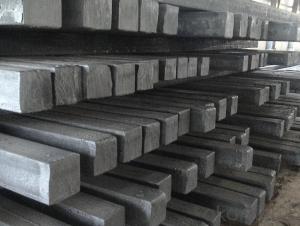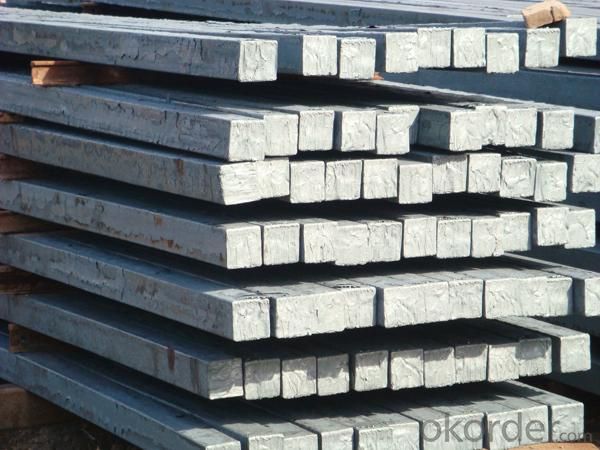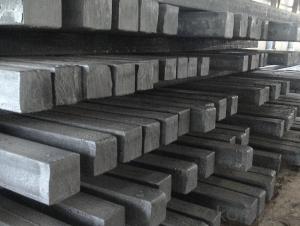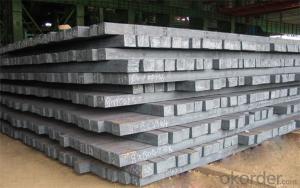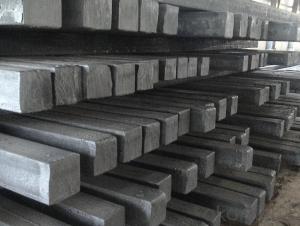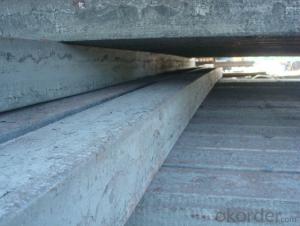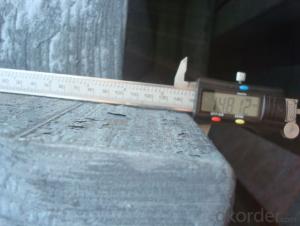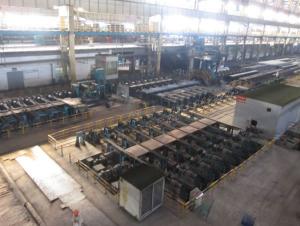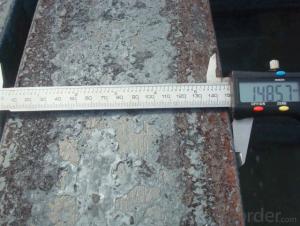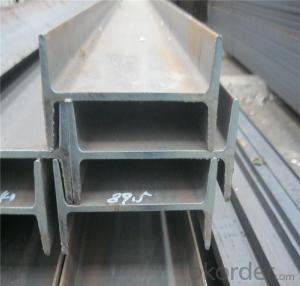Steel I Beam EN 10025 S235JR GB Q235B 80-270MM
- Loading Port:
- Shanghai
- Payment Terms:
- TT or LC
- Min Order Qty:
- 25 m.t.
- Supply Capability:
- 200000 m.t./month
OKorder Service Pledge
OKorder Financial Service
You Might Also Like
Product Description:
OKorder is offering high quality Hot Rolled Steel I-Beams at great prices with worldwide shipping. Our supplier is a world-class manufacturer of steel, with our products utilized the world over. OKorder annually supplies products to European, North American and Asian markets. We provide quotations within 24 hours of receiving an inquiry and guarantee competitive prices.
Product Applications:
Hot Rolled Steel I-Beams are ideal for structural applications and are widely used in the construction of buildings and bridges, and the manufacturing, petrochemical, and transportation industries.
Product Advantages:
OKorder's Steel I-Beams are durable, strong, and resist corrosion.
Main Product Features:
· Premium quality
· Prompt delivery & seaworthy packing (30 days after receiving deposit)
· Corrosion resistance
· Can be recycled and reused
· Mill test certification
· Professional Service
· Competitive pricing
Product Specifications:
Manufacture: Hot rolled
Grade: Q195 – 235
Certificates: ISO, SGS, BV, CIQ
Length: 6m – 12m, as per customer request
Packaging: Export packing, nude packing, bundled
Chinese Standard (H*W*T) | Weight (Kg/m) | 6m (pcs/ton) | Light I (H*W*T) | Weight (Kg/m) | 6m (pcs/ton) | Light II (H*W*T) | Weight (Kg/m) | 6M |
100*68*4.5 | 11.261 | 14.8 | 100*66*4.3 | 10.13 | 16.4 | 100*64*4 | 8.45 | 19.7 |
120*74*5.0 | 13.987 | 11.9 | 120*72*4.8 | 12.59 | 13.2 | 120*70*4.5 | 10.49 | 15.8 |
140*80*5.5 | 16.89 | 9.8 | 140*78*5.3 | 15.2 | 10.9 | 140*76*5 | 12.67 | 13.1 |
160*88*6 | 20.513 | 8.1 | 160*86*5.8 | 18.46 | 9 | 160*84*5.5 | 15.38 | 10.8 |
180*94*6.5 | 24.143 | 6.9 | 180*92*6.3 | 21.73 | 7.6 | 180*90*6 | 18.11 | 9.2 |
200*100*7 | 27.929 | 5.9 | 200*98*6.8 | 25.14 | 6.6 | 200*96*6.5 | 20.95 | 7.9 |
220*110*7.5 | 33.07 | 5 | 220*108*7.3 | 29.76 | 5.6 | 220*106*7 | 24.8 | 6.7 |
250*116*8 | 38.105 | 4.3 | 250*114*7.8 | 34.29 | 4.8 | 250*112*7.5 | 28.58 | 5.8 |
280*122*8.5 | 43.492 | 3.8 | 280*120*8.2 | 39.14 | 4.2 | 280*120*8 | 36.97 | 4.5 |
300*126*9 | 48.084 | 3.4 | 300*124*9.2 | 43.28 | 3.8 | 300*124*8.5 | 40.87 | 4 |
320*130*9.5 | 52.717 | 3.1 | 320*127*9.2 | 48.5 | 3.4 | |||
360*136*10 | 60.037 | 2.7 | 360*132*9.5 | 55.23 | 3 |
FAQ:
Q1: How soon can we receive the product after purchase?
A1: Within three days of placing an order, we will begin production. The specific shipping date is dependent upon international and government factors, but is typically 7 to 10 workdays.
Q2: What makes stainless steel stainless?
A2: Stainless steel must contain at least 10.5 % chromium. It is this element that reacts with the oxygen in the air to form a complex chrome-oxide surface layer that is invisible but strong enough to prevent further oxygen from "staining" (rusting) the surface. Higher levels of chromium and the addition of other alloying elements such as nickel and molybdenum enhance this surface layer and improve the corrosion resistance of the stainless material.
Q3: Can stainless steel rust?
A3: Stainless does not "rust" as you think of regular steel rusting with a red oxide on the surface that flakes off. If you see red rust it is probably due to some iron particles that have contaminated the surface of the stainless steel and it is these iron particles that are rusting. Look at the source of the rusting and see if you can remove it from the surface.
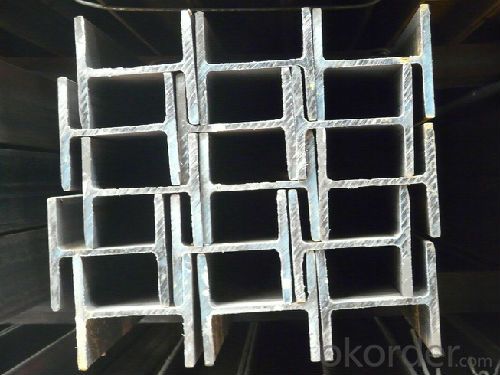
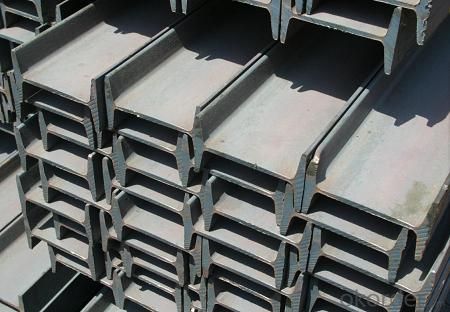
- Q: How are steel billets used in the manufacturing of shafts?
- Steel billets are used in the manufacturing of shafts as the starting material. The billets are heated and then shaped and machined into the desired shape and size of the shaft. This process ensures that the shafts are strong, durable, and able to withstand the required loads and stresses in various applications.
- Q: What are the different types of steel billet shearing machines?
- There are several different types of steel billet shearing machines available in the market, each designed to cater to specific needs and requirements. Some of the most common types include: 1. Hydraulic Billet Shearing Machine: This type of machine utilizes hydraulic power to cut steel billets with precision and efficiency. It offers a high cutting force and can handle larger billet sizes. 2. Mechanical Billet Shearing Machine: These machines use mechanical force, such as a flywheel or a cam-operated mechanism, to cut the steel billets. They are typically compact and suitable for smaller billet sizes. 3. Pneumatic Billet Shearing Machine: This type of machine employs pneumatic pressure to shear the steel billets. It is commonly used in applications where hydraulic or mechanical power may not be available or suitable. 4. CNC Billet Shearing Machine: CNC (Computer Numerical Control) machines offer automated and precise cutting of steel billets. They can be programmed to perform complex cuts and are suitable for high-volume production environments. 5. Rotary Billet Shearing Machine: This machine utilizes a rotary blade to cut the steel billets. It offers a continuous cutting motion and is ideal for cutting larger billet sizes or long-length materials. 6. Cold Billet Shearing Machine: This type of machine is specifically designed for cutting cold billets. It uses a combination of hydraulic or mechanical force and can handle materials that may be more brittle when cold. 7. Hot Billet Shearing Machine: Hot billet shearing machines are designed to cut steel billets at high temperatures. They are equipped with specialized blades and cooling systems to handle the heat generated during the cutting process. These are just a few examples of the different types of steel billet shearing machines available in the market. The choice of machine depends on factors such as the size and thickness of the billets, required precision, production volume, and specific application requirements. It is important to consider these factors and consult with a professional to determine the most suitable machine for your needs.
- Q: What types of steel are commonly used for billets?
- There are several types of steel that are commonly used for billets, depending on the specific application and desired properties. One common type is carbon steel, which is an alloy of iron and carbon. Carbon steel billets are widely used because of their high strength, durability, and affordability. They are suitable for a variety of applications, including construction, automotive, and machinery industries. Another type of steel used for billets is alloy steel. Alloy steel billets are made by adding various alloying elements such as chromium, nickel, and molybdenum to carbon steel. These alloying elements enhance the strength, toughness, and corrosion resistance of the steel, making it suitable for more demanding applications like aerospace, oil and gas, and power generation. Stainless steel is also commonly used for billets, especially in applications where corrosion resistance is critical, such as in marine environments or food processing industries. Stainless steel billets are made by adding chromium and sometimes other elements like nickel or molybdenum to carbon steel. This combination of elements provides excellent resistance to corrosion, high temperatures, and chemicals. Finally, tool steel is another type of steel used for billets, primarily in the manufacturing of tools and dies. Tool steel billets are made with specific alloying elements like tungsten, vanadium, or cobalt, which give them exceptional hardness, wear resistance, and heat resistance properties. These billets are essential for producing precision tools and components used in industries such as automotive, aerospace, and manufacturing. In summary, the types of steel commonly used for billets include carbon steel, alloy steel, stainless steel, and tool steel. The choice of steel depends on the specific application requirements, such as strength, corrosion resistance, or hardness.
- Q: How are steel billets used in the manufacturing of oil and gas industry components?
- Steel billets are an essential raw material used in the manufacturing of various components for the oil and gas industry. These billets, which are semi-finished steel products, play a crucial role in the production of pipes, valves, fittings, and other equipment required for oil and gas extraction, transportation, and processing. One of the primary applications of steel billets in the oil and gas industry is in the production of seamless and welded pipes. These pipes are used extensively for the transportation of oil, gas, and other fluids over long distances. Steel billets are first heated and then passed through a series of rollers to form seamless pipes. In the case of welded pipes, the billets are first formed into a tube shape and then welded along the length to create a strong and durable pipe. Steel billets are also used in the manufacturing of valves, which are crucial components in the oil and gas industry. Valves are used to control the flow of fluids within pipelines and equipment. Billets are machined and shaped to create valve bodies, which are then fitted with various internal components such as seats, discs, and stems. These valves are designed to withstand high pressures and temperatures, ensuring reliable and safe operation in the oil and gas industry. Furthermore, steel billets are utilized in the production of fittings, which are used to connect and join pipes together. Fittings such as elbows, tees, couplings, and flanges are manufactured from billets by machining and shaping them into the required dimensions and configurations. These fittings play a critical role in creating a reliable and leak-free pipeline system for the transportation of oil and gas. In addition to pipes, valves, and fittings, steel billets also find applications in the manufacturing of other equipment used in the oil and gas industry. These include drill bits, pumps, compressors, and various structural components for offshore platforms and refineries. The strength, durability, and corrosion resistance of steel make it an ideal material for these demanding applications, and steel billets serve as the starting point for their production. In conclusion, steel billets are a crucial raw material in the manufacturing of components for the oil and gas industry. Whether it is pipes, valves, fittings, or other equipment, billets are transformed through various processes to create the essential components required for the extraction, transportation, and processing of oil and gas.
- Q: How are steel billets inspected for surface finish?
- Steel billets are inspected for surface finish using different methods and techniques to ensure quality and compliance with industry standards. One common method is visual inspection, where trained inspectors visually examine the surface of the billet for any defects such as scratches, pits, cracks, or any other irregularities. This inspection is typically done under proper lighting conditions to enhance the visibility of any imperfections. Another method used is non-destructive testing (NDT), which includes techniques such as magnetic particle inspection (MPI) and liquid penetrant inspection (LPI). MPI involves applying a magnetic field to the billet and then applying a magnetic particle suspension that will reveal any surface defects by adhering to them. LPI, on the other hand, involves applying a liquid penetrant solution to the surface of the billet, which is then removed and followed by the application of a developer that highlights any defects. Ultrasonic testing (UT) is another commonly used technique for inspecting the surface finish of steel billets. UT utilizes high-frequency sound waves that are transmitted through the billet, and any reflected waves are analyzed to detect any surface or subsurface defects. This method can provide detailed information about the surface condition and can detect even minute flaws. In addition to these methods, surface profilometers can be used to measure the roughness of the billet's surface. These devices use a stylus or laser to measure the height variations on the surface, providing data on the roughness and texture. Overall, steel billets undergo thorough inspection for surface finish using a combination of visual inspection, NDT techniques, and surface profilometry. These inspections help ensure that the billets meet the required surface finish standards and are suitable for further processing or manufacturing.
- Q: What do you mean by adding carbon to a table tennis racket?
- What a professional? I don't know what is known but with carbon carbon line take this hit the ball the more comfortable to take shape
- Q: Use medium frequency furnace (1 million 500 thousand volt ampere) to produce 1 ton cast steel blank, how much kilowatt hour is consumed?
- Look at the quality of scrap and the operation of workers, power consumption is generally between 550~650.
- Q: What are the potential defects or flaws in steel billets?
- Steel billets may experience various defects or flaws that can impact the final product's quality and performance. Some of these defects include the following: 1. Surface imperfections: During manufacturing, steel billets may develop surface cracks, scales, or scratches. These imperfections can weaken the material and compromise its structural integrity. 2. Internal flaws: Inclusions, such as non-metallic impurities or gas bubbles, may be present within the steel billets. These internal flaws can create localized weaknesses and reduce the overall material strength. 3. Segregation: Uneven distribution of alloying elements or impurities can result in segregation, where different areas of the billet have varying chemical compositions. Segregation can lead to inconsistent mechanical properties and decrease material uniformity. 4. Central segregation: This defect occurs when impurities or alloying elements concentrate in the central region of the billet, resulting in a weaker core. Central segregation can cause structural failures and decrease the overall reliability of the steel billet. 5. Shrinkage cavities: During solidification, the contraction of molten metal can lead to the formation of shrinkage cavities in the steel billet. These cavities can weaken the material and compromise its structural integrity. 6. Surface decarburization: High temperatures or improper heat treatment can cause the surface of the steel billet to lose carbon content, resulting in surface decarburization. This defect can reduce the material's hardness and strength. 7. Laminations: Thin, elongated voids or layers known as laminations can form parallel to the billet's surface. These defects can weaken the material and make it susceptible to cracking or failure under stress. 8. Internal fissures: Improper cooling or handling during manufacturing can lead to internal fissures or cracks. These cracks can jeopardize the structural integrity of the steel billet and potentially lead to catastrophic failure. It is crucial to detect and address these defects early on to ensure the quality and reliability of the steel billets. Several non-destructive testing techniques, such as ultrasonic testing or magnetic particle inspection, can be employed to identify and mitigate these potential flaws.
- Q: How are steel billets used in the production of forged parts?
- Steel billets are used in the production of forged parts as they serve as the starting material for the forging process. The billets are heated to a specific temperature and then shaped into the desired form by applying pressure or impact using a forging press or hammer. This process enhances the strength and durability of the steel, resulting in high-quality forged parts that are used in various industries such as automotive, aerospace, and construction.
- Q: How are steel billets used in the shipbuilding industry?
- Steel billets are an integral component in the shipbuilding industry, primarily used for the construction of various parts and structures of ships. These billets serve as the raw material for manufacturing essential components such as hulls, frames, bulkheads, and other structural elements. Shipbuilding requires steel with exceptional strength, durability, and corrosion resistance, making steel billets an ideal choice due to their high-quality composition and properties. The billets are first shaped and formed into the desired dimensions, which can vary depending on the specific requirements of the ship's design. Once the steel billets are prepared, they are then used in various shipbuilding processes. One of the key applications is in the construction of the ship's hull, which is the external structure that provides the necessary strength and buoyancy. Steel billets are cut and welded together to form the hull's framework, ensuring the ship's structural integrity and stability. Additionally, steel billets are employed in manufacturing frames, bulkheads, and decks. Frames provide the structural support and rigidity to the ship's framework, while bulkheads divide the ship's internal space into separate compartments, enhancing safety and preventing water ingress in case of any damage. Decks, on the other hand, serve as the floors of different levels within the ship. Moreover, steel billets are used in the fabrication of various equipment and machinery installed on the ship. These include propulsion systems, cranes, winches, and other heavy-duty components that contribute to the ship's functionality and operational capabilities. Overall, steel billets play a crucial role in the shipbuilding industry as they form the foundation for constructing ships and their essential components. The high-quality steel and its versatility allow shipbuilders to create vessels that meet stringent safety standards, withstand harsh marine conditions, and ensure the longevity of the ships throughout their service life.
Send your message to us
Steel I Beam EN 10025 S235JR GB Q235B 80-270MM
- Loading Port:
- Shanghai
- Payment Terms:
- TT or LC
- Min Order Qty:
- 25 m.t.
- Supply Capability:
- 200000 m.t./month
OKorder Service Pledge
OKorder Financial Service
Similar products
Hot products
Hot Searches
Related keywords
